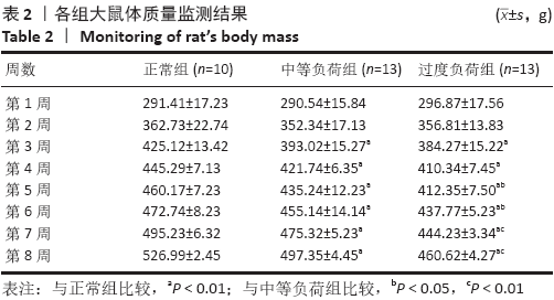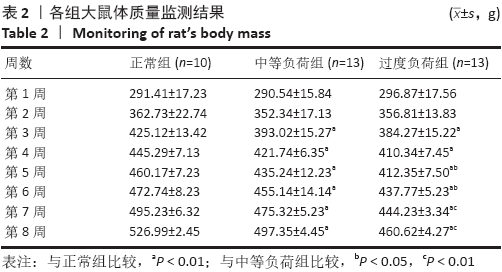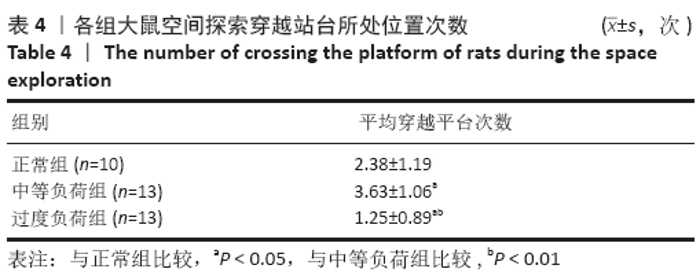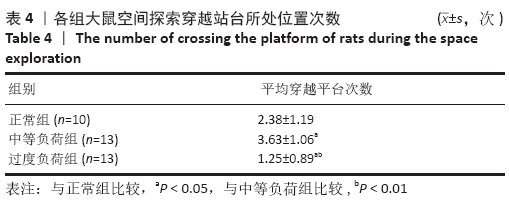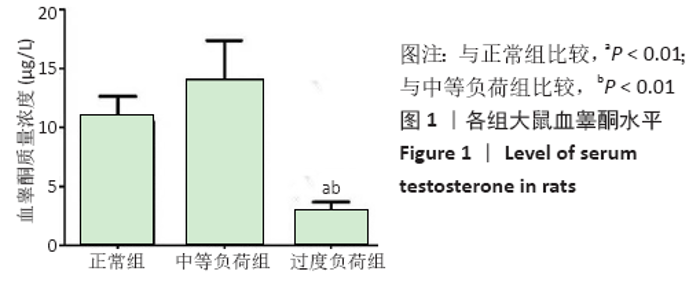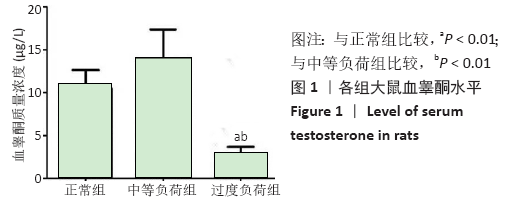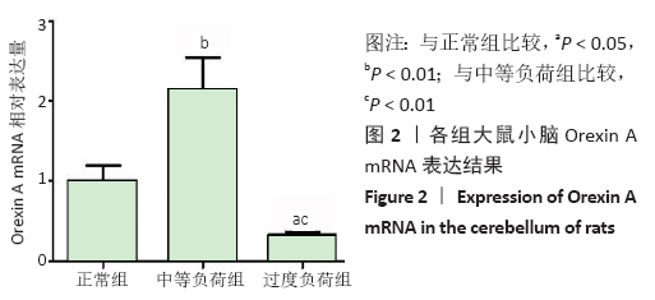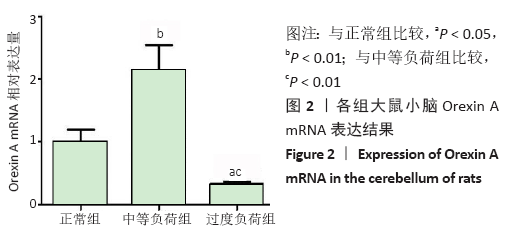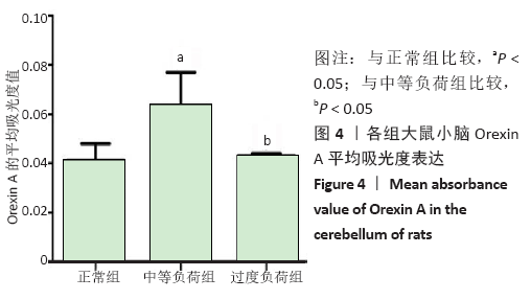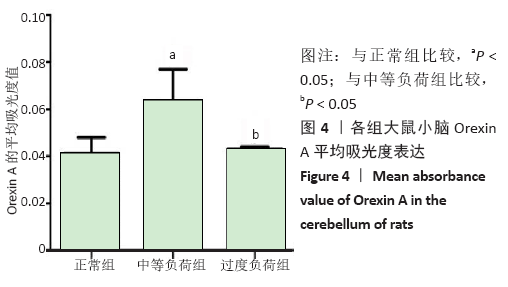Chinese Journal of Tissue Engineering Research ›› 2021, Vol. 25 ›› Issue (23): 3697-3703.doi: 10.12307/2021.042
Previous Articles Next Articles
Effects of different-intensity swimming exercises on spatial learning and memory ability and the expression of Orexin A in the rat cerebellum
Lu Jie1, 2, Li Xue1, Wang Lu1, Fan Jia1, Zhang Yeting1, Lu Xiaobin3, Yuan Qiongjia1
- 1School of Sports Medicine and Health, Chengdu Sport University, Chengdu 610041, Sichuan Province, China; 2Suzhou Institute of Sports Science, Suzhou 215131, Jiangsu Province, China; 3School of Physical Education, Sichuan Agricultural University, Yaan 625014, Sichuan Province, China
-
Received:2020-05-25Revised:2020-05-28Accepted:2020-07-11Online:2021-08-18Published:2021-02-24 -
Contact:Yuan Qiongjia, MD, Professor, School of Sports Medicine and Health, Chengdu Sport University, Chengdu 610041, Sichuan Province, China -
About author:Lu Jie, Master, Assistant researcher, School of Sports and Health, Chengdu Sport University, Chengdu 610041, Sichuan Province, China; Suzhou Institute of Sports Science, Suzhou 215131, Jiangsu Province, China -
Supported by:the National Natural Science Foundation of China, No. 31371202 (to YQJ)
CLC Number:
Cite this article
Lu Jie, Li Xue, Wang Lu, Fan Jia, Zhang Yeting, Lu Xiaobin, Yuan Qiongjia. Effects of different-intensity swimming exercises on spatial learning and memory ability and the expression of Orexin A in the rat cerebellum[J]. Chinese Journal of Tissue Engineering Research, 2021, 25(23): 3697-3703.
share this article
Add to citation manager EndNote|Reference Manager|ProCite|BibTeX|RefWorks
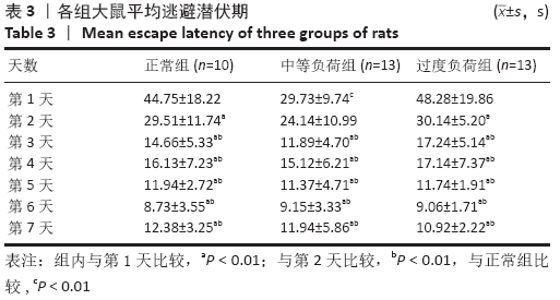
2.3 Morris水迷宫实验结果 通过7 d定位航行测试,各组大鼠平均逃避潜伏期结果(表3):水迷宫实验的第1天,在3组大鼠中,中等负荷组定位航行耗时最短,最先探索到平台,平均潜伏用时较正常组明显降低(P < 0.01),在第1天的潜伏用时比较中,过度负荷组和正常组相比差异无显著性意义(P > 0.05);3组大鼠第2天平均潜伏用时和第1天比,正常组和过度负荷组大鼠均明显减短(P < 0.01),中等负荷组大鼠未出现明显降低(P > 0.05);第3天的平均潜伏用时和第2天比较,正常组、中等负荷组和过度负荷组大鼠均出现明显减短(P < 0.01);第4天平均潜伏用时和第3天比,正常组、中等负荷组和过度负荷组大鼠均未出现明显变化(P > 0.05),同时,在第4天,与正常组相比,中等负荷组和过度负荷组大鼠平均潜伏用时未出现明显差异(P > 0.05),出现“平台”现象。 "
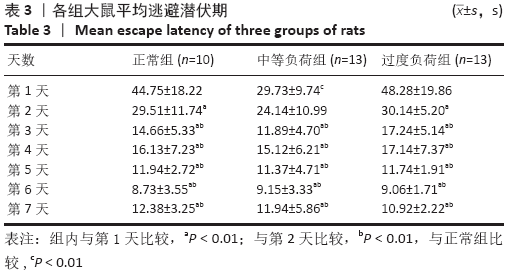
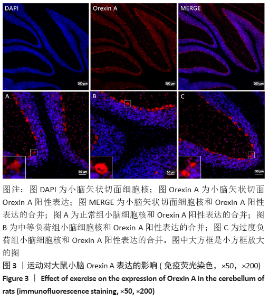
2.6 免疫荧光检测小脑Orexin A蛋白表达 Orexin A蛋白在小脑皮质的颗粒细胞层和蒲肯野细胞层均有阳性表达,在蒲肯野细胞中表达非常明显,阳性表达分布在小脑神经细胞的胞浆中,并在细胞核周围围绕(图3)。免疫荧光吸光度定量深入探究发现(图4),与正常组免疫荧光平均吸光度(0.041±0.007)比较,中等负荷组小脑Orexin A免疫荧光平均吸光度(0.063±0.014)升高显著(P < 0.05),过度负荷组Orexin A免疫荧光平均吸光度(0.043±0.001)未出现明显降低(P > 0.05);与中等负荷组相比,过度负荷组小脑Orexin A免疫荧光平均吸光度显著降低(P < 0.05)。 2.7 小脑中Orexin A 表达和空间学习以及记忆能力的关系 为了进一步求证大鼠小脑Orexin A的表达量和平均潜伏用时以及穿越站台所处位置的次数的关系,进行了偏相关分析(partial correlation):3组大鼠小脑中Orexin A蛋白表达量和平均潜伏用时呈负相关(r=-0.770,P=0.025);3组大鼠小脑中Orexin A mRNA表达量和平均潜伏用时呈负相关(r=-0.709,P=0.049);3组大鼠小脑中Orexin A蛋白表达量和穿越站台所处位置的次数呈正相关(r=0.717,P=0.046);3组大鼠小脑中Orexin A mRNA表达量和穿越站台所处位置的次数呈正相关(r=0.725,P=0.042)。 "
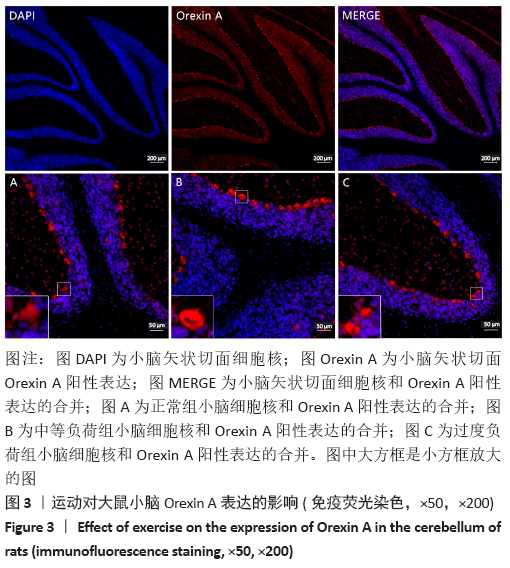
| [1] Helleringer R, Le Verger D, Li X, et al. Cerebellar synapse properties and cerebellum-dependent motor and non-motor performance in Dp71-null mice. Dis Model Mech. 2018;11(7):1-10. [2] Shipman ML, Green JT. Cerebellum and cognition:does the rodent cerebellum participate in cognitive functions? Neurobiol Learn Mem. 2019;106996. [3] Lefort JM, Vincent J, Tallot L, et al. Impaired cerebellar purkinje cell potentiation generates unstable spatial map orientation and inaccurate navigation. Nat Commun. 2019;10(1):2251. [4] CASSILHAS RC, TUFIK S, DE MELLO MT. Physical exercise, neuroplasticity, spatial learning and memory. Cell Mol Life Sci. 2016;73(5):975-983. [5] 付燕,张业廷,罗笑,等.有氧运动对Aβ1-42诱导阿尔茨海默病大鼠学习记忆能力及海马炎症状态的影响[J].中国运动医学杂志, 2018,37(8):676. [6] 崔建梅,郭燕兰,李中华,等.运动预干预对睡眠剥夺大鼠学习记忆及海马nNOS表达的影响[J].神经解剖学杂志,2019,35(3):317-319. [7] SHIMIZU S, TAKENOSHITA N, INAGAWA Y, et al. Positive association between cognitive function and cerebrospinal fluid orexin A levels in Alzheimer’s disease. J Alzheimers Dis. 2020;73(1):117-123. [8] 齐爱萍.大鼠内嗅皮层微注射Orexin-A对睡眠—觉醒及空间记忆的影响[D].重庆:陆军军医大学,2012. [9] CHIEFFI S, CAROTENUTO M, MONDA V, et al. Orexin System:The key for a healthy life. Front Physiol. 2017;8(357):1-6. [10] 朱全,张敏,浦钧宗.游泳方法建立大鼠模拟过度训练模型[J].中国运动医学杂志,1998,17(2):137-140. [11] VORHEES CV, WILLIAMS MT. Assessing spatial learning and memory in rodents. ILAR J. 2014;55(2):310-329. [12] 许杰,谢敏豪,严翊.12周不同强度运动干预对大鼠心肺耐力的改善效果[J].中国运动医学杂志,2017,36(6):479-481. [13] 袁琼嘉,李垂坤,李雪,等.长期大负荷运动对大鼠空间学习记忆及海马神经粘附分子的影响[J].成都体育学院,2014,40(11):79-81. [14] 吴迎,曾凡星,李奕.长期不同负荷运动对心肌MAPK信号通路的影响[J].中国体育科技,2013,49(6):94-98. [15] CASTO KV, RIVELL A, EDWARDS DA. Competition-related testosterone, cortisol,and perceived personal success in recreational women athletes. Horm Behav. 2017;92(6):29-35. [16] 翁锡全,林洁如,徐国琴,等.枸杞汁对男性大学生递增负荷运动期间血睾酮及皮质醇水平的影响[J].中国运动医学杂志,2016, 35(40):346-348. [17] 王瑞米.中等强度游泳运动对大鼠睾酮含量的影响[D].郑州:河南师范大学,2014. [18] 严翊,谢敏豪.运动对睾酮及其代谢影响的研究现状[J].中国运动医学杂志,2007,26(6):773-776. [19] BOHNE P, SCHWARZ MK, HERLITZE S, et al. A new projection from the deep cerebellar nuclei to the hippocampus via the ventrolateral and laterodorsal thalamus in mice. Front Neural Circuits. 2019;13:51. [20] LOCKE TM, SODEN ME, MILLER SM, et al. Dopamine D1 receptor-positive neurons in the lateral nucleus of the cerebellum contribute to cognitive behavior. Biol Psychiatry. 2018;84(6):401-412. [21] 范佳,李雪,王璐,等.有氧运动干预对衰老大鼠学习记忆能力及小脑生长相关蛋白-43表达的影响[J].中国康复医学杂志,2019, 34(4):392-394. [22] 张业廷,付燕,李雪,等.不同负荷游泳运动对大鼠海马突触后致密区蛋白95、神经细胞黏附分子蛋白表达的影响[J].中国组织工程研究,2019,23(19):3067-3071. [23] 闫清伟,徐波,田青.跑台运动改善海马线粒体功能提高APP/PS1小鼠学习记忆能力[J].中国生物化学与分子生物学报,2019,35(6): 669-677. [24] 崔建梅,郭燕兰,李中华,等.跑台运动对慢性睡眠剥夺大鼠行为学改变、海马炎症因子及海马齿状回BDNF/TrkB信号通路的影响[J].体育科学,2019,39(6):62-72. [25] WU Y, DENG F, WANG J, et al. Intensity-dependent effects of consecutive treadmill exercise on spatial learning and memory through the p-CREB/BDNF/NMDAR signaling in hippocampus. Behav Brain Res. 2020;386:112599. [26] POLITO R, MONDA V, NIGRO E, et al. The important role of adiponectin and orexin-A,two key proteins improving healthy status:focus on physical activity. Front Physiol. 2020;11:356. [27] JIN T, JIANG Z, LUAN X, et al. Exogenous orexin-A microinjected into central nucleus of the amygdala modulates feeding and gastric motility in rats. Front Neurosci. 2020;14:274. [28] NEPOVIMOVA E, JANOCKOVA J, MISIK J, et al. Orexin supplementation in narcolepsy treatment:a review. Med Res Rev. 2019;39(3):961-975. [29] CHIEFFI S, MESSINA G, VILLANO I, et al. Exercise influence on hippocampal function:possible involvement of orexin-A. Front Physiol. 2017;8:85. [30] KULIK YD, WATSON DJ, CAO G, et al. Structural plasticity of dendritic secretory compartments during LTP-induced synaptogenesis. Elife. 2019;8:e46356. [31] BARNES JR, MUKHERJEE B, ROGERS BC, et al. The relationship between glutamate dynamics and activity-dependent synaptic plasticity. J Neurosci. 2020;40(14):2793-2807. [32] LYU D, TANG N, WOMACK AW, et al. Neonatal ketamine exposure-induced hippocampal neuroapoptosis in the developing brain impairs adult spatial learning ability. Neural Regen Res. 2020;15(5):880-886. [33] LU GL, LEE CH, CHIOU LC. Orexin A induces bidirectional modulation of synaptic plasticity:inhibiting long-term potentiation and preventing depotentiation. Neuropharmacology. 2016;107:168-180. [34] ZHAO X, ZHANG RX, TANG S, et al. Orexin-A-induced ERK1/2 activation reverses impaired spatial learning and memory in pentylenetetrazol-kindled rats via OX1R-mediated hippocampal neurogenesis. Peptides. 2014;54:147. [35] 孙杰,李筹忠,王曲,等.Orexin-A对癫痫大鼠学习记忆能力及海马齿状回神经细胞增殖的影响[J].中国老年学杂志,2015,35(17): 4802-4804. [36] HAN D, HAN F, SHI Y, et al. Mechanisms of memory impairment induced by orexin-A via orexin 1 and orexin 2 receptors in post-traumatic stress disorder rats. Neuroscience. 2020;432:126-136. [37] SHAHSAVARI F, ABBASNEJAD M, ESMAEILI-MAHANI S, et al. Orexin-1 receptors in the rostral ventromedial medulla are involved in the modulation of capsaicin evoked pulpal nociception and impairment of learning and memory. Int Endod J. 2018;51(12):1398-1409. [38] CIRIELLO J, CAVERSON MM. Hypothalamic orexin-A(hypocretin-1)neuronal projections to the vestibular complex and cerebellum in the rat. Brain Res. 2014;1579:20-34. [39] GAO BY, XU DS, LIU PL, et al. Modified constraint-induced movement therapy alters synaptic plasticity of rat contralateral hippocampus following middle cerebral artery occlusion. Neural Regen Res. 2020; 15(6):1045-1057. [40] KAKEGAWA W, KATOH A, NARUMI S, et al. Optogenetic control of synaptic AMPA receptor endocytosis reveals roles of LTD in motor learning. Neuron. 2018;99(5):985-998. |
| [1] | Zhang Chao, Lü Xin. Heterotopic ossification after acetabular fracture fixation: risk factors, prevention and treatment progress [J]. Chinese Journal of Tissue Engineering Research, 2021, 25(9): 1434-1439. |
| [2] | Wang Yongsheng, Wu Yang, Li Yanchun. Effect of acute high-intensity exercise on appetite hormones in adults: a meta-analysis [J]. Chinese Journal of Tissue Engineering Research, 2021, 25(8): 1305-1312. |
| [3] | Wu Xun, Meng Juanhong, Zhang Jianyun, Wang Liang. Concentrated growth factors in the repair of a full-thickness condylar cartilage defect in a rabbit [J]. Chinese Journal of Tissue Engineering Research, 2021, 25(8): 1166-1171. |
| [4] | Shen Jinbo, Zhang Lin. Micro-injury of the Achilles tendon caused by acute exhaustive exercise in rats: ultrastructural changes and mechanism [J]. Chinese Journal of Tissue Engineering Research, 2021, 25(8): 1190-1195. |
| [5] | Li Jing, Xie Jianshan, Cui Huilin, Cao Ximei, Yang Yanping, Li Hairong. Expression and localization of diacylglycerol kinase zeta and protein kinase C beta II in mouse back skin with different coat colors [J]. Chinese Journal of Tissue Engineering Research, 2021, 25(8): 1196-1200. |
| [6] | Tan Jingyu, Liu Haiwen. Genome-wide identification, classification and phylogenetic analysis of Fasciclin gene family for osteoblast specific factor 2 [J]. Chinese Journal of Tissue Engineering Research, 2021, 25(8): 1243-1248. |
| [7] | Wang Mengting, Gu Yanping, Ren Wenbo, Qin Qian, Bai Bingyi, Liao Yuanpeng. Research hotspots of blood flow restriction training for dyskinesia based on visualization analysis [J]. Chinese Journal of Tissue Engineering Research, 2021, 25(8): 1264-1269. |
| [8] | Wang Zhengdong, Huang Na, Chen Jingxian, Zheng Zuobing, Hu Xinyu, Li Mei, Su Xiao, Su Xuesen, Yan Nan. Inhibitory effects of sodium butyrate on microglial activation and expression of inflammatory factors induced by fluorosis [J]. Chinese Journal of Tissue Engineering Research, 2021, 25(7): 1075-1080. |
| [9] | Kong Desheng, He Jingjing, Feng Baofeng, Guo Ruiyun, Asiamah Ernest Amponsah, Lü Fei, Zhang Shuhan, Zhang Xiaolin, Ma Jun, Cui Huixian. Efficacy of mesenchymal stem cells in the spinal cord injury of large animal models: a meta-analysis [J]. Chinese Journal of Tissue Engineering Research, 2021, 25(7): 1142-1148. |
| [10] | Shi Yangyang, Qin Yingfei, Wu Fuling, He Xiao, Zhang Xuejing. Pretreatment of placental mesenchymal stem cells to prevent bronchiolitis in mice [J]. Chinese Journal of Tissue Engineering Research, 2021, 25(7): 991-995. |
| [11] | Fan Quanbao, Luo Huina, Wang Bingyun, Chen Shengfeng, Cui Lianxu, Jiang Wenkang, Zhao Mingming, Wang Jingjing, Luo Dongzhang, Chen Zhisheng, Bai Yinshan, Liu Canying, Zhang Hui. Biological characteristics of canine adipose-derived mesenchymal stem cells cultured in hypoxia [J]. Chinese Journal of Tissue Engineering Research, 2021, 25(7): 1002-1007. |
| [12] | Geng Yao, Yin Zhiliang, Li Xingping, Xiao Dongqin, Hou Weiguang. Role of hsa-miRNA-223-3p in regulating osteogenic differentiation of human bone marrow mesenchymal stem cells [J]. Chinese Journal of Tissue Engineering Research, 2021, 25(7): 1008-1013. |
| [13] | Lun Zhigang, Jin Jing, Wang Tianyan, Li Aimin. Effect of peroxiredoxin 6 on proliferation and differentiation of bone marrow mesenchymal stem cells into neural lineage in vitro [J]. Chinese Journal of Tissue Engineering Research, 2021, 25(7): 1014-1018. |
| [14] | Duan Liyun, Cao Xiaocang. Human placenta mesenchymal stem cells-derived extracellular vesicles regulate collagen deposition in intestinal mucosa of mice with colitis [J]. Chinese Journal of Tissue Engineering Research, 2021, 25(7): 1026-1031. |
| [15] | Guan Qian, Luan Zuo, Ye Dou, Yang Yinxiang, Wang Zhaoyan, Wang Qian, Yao Ruiqin. Morphological changes in human oligodendrocyte progenitor cells during passage [J]. Chinese Journal of Tissue Engineering Research, 2021, 25(7): 1045-1049. |
| Viewed | ||||||
|
Full text |
|
|||||
|
Abstract |
|
|||||
